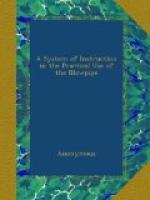Boracic acid is incombustible, and has a strong affinity for oxides when fused with them; therefore, it not only directly combines with oxides, but it expels, by fusion, all other volatile acids from their salts. Furthermore, boracic acid promotes the oxidation of metals and sulphur, and induces haloid compounds, in the oxidation flame, to combine with the rising oxides. Borates thus made, melt generally by themselves; but admixed with borate of soda, they fuse much more readily, give a clear bead. Borax acts either as a flux, or through the formation of double salts.
In borax, we have the action of free boracic acid, as well as borate of soda, and for that reason it is an excellent reagent for blowpipe analysis.
All experiments in which borax is employed should be effected upon platinum wire. The hook of the wire should be heated red hot, and then dipped into the powdered borax. This should be exposed to the oxidation flame, when it will be fused to a bead, which adheres to the hook. This should be then dipped into the powdered substance, which will adhere to it if it is hot; but if the bead is cool, it must be previously moistened. Expose this bead to the oxidation flame until it ceases to change, then allow it to cool, when it should be exposed to the reduction flame. Look for the following in the oxidation flame:
(1.) Whether the heated substance is fused to a clear bead or not, and whether the bead remains transparent after cooling. The beads of some substances, for instance those of the alkaline earths, are clear while hot; but upon cooling, are milk-white and enamelled. Some substances give a clear bead when heated and when cold, but appear enamelled when heated intermittingly or with a flame which changes often from oxidation to reduction, or with an unsteady flame produced by too strong a blast. The reason is an incomplete fusion, while from the basic borate compound a part of the base is separated. As the boracic acid is capable of dissolving more in the heat, a bead will be clear while hot, enamelled when cold, as a part in the latter instance will become separated.
(2.) Whether the substance dissolves
easily or not, and whether
it intumesces from arising gases.
(3.) Whether the bead, when exposed
to the oxidation flame,
exhibits any color, and whether
the color remains after the bead
shall have cooled, or whether the
color fades.
(4.) Whether the bead exhibits any
other reaction in the
reduction flame.
The bead should not be overcharged with the substance under examination, or it will become colored so deeply as not to present any transparency, or the color light enough to discern its hue.
8. Microcosmic Salt—Phosphate of Soda and Ammonia—(NaO, NH^{4}O + PO^{5}).—Dissolve six parts of phosphate of soda (2NaO, HO, PO^{5}), and one part of pure chloride of Ammonium (NH^{4}Cl.), in two parts of boiling water, and allow it to cool. The greatest part of the formed double salt crystallizes, while the mother-liquid contains chloride of sodium, and some of the double salt. The crystals must be dissolved in as little boiling water as possible, and re-crystallized. These crystals must be dried and powdered.




